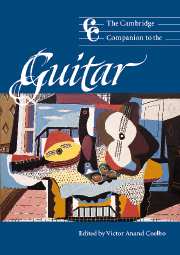Book contents
- Frontmatter
- Part I New guitar histories and world traditions
- 1 Picking through cultures: a guitarist's music history
- 2 Flamenco guitar: history, style, status
- 3 The Celtic guitar: crossing cultural boundaries in the twentieth century
- 4 African reinventions of the guitar
- Part II Jazz, roots, and rock
- Part III Baroque and classical guitar today
- Glossary
- Notes
- Select bibliography
- General index
- Index of song and album titles
3 - The Celtic guitar: crossing cultural boundaries in the twentieth century
from Part I - New guitar histories and world traditions
Published online by Cambridge University Press: 28 September 2011
- Frontmatter
- Part I New guitar histories and world traditions
- 1 Picking through cultures: a guitarist's music history
- 2 Flamenco guitar: history, style, status
- 3 The Celtic guitar: crossing cultural boundaries in the twentieth century
- 4 African reinventions of the guitar
- Part II Jazz, roots, and rock
- Part III Baroque and classical guitar today
- Glossary
- Notes
- Select bibliography
- General index
- Index of song and album titles
Summary
Introduction
Ever since its incarnation in modern form, the guitar's adaptability to different musical roles has led to its use in a wide variety of indigenous music. According to ethnomusicologist and virtuoso slide player Bob Brozman, the cross-cultural impact of the guitar results from the contact between the instrument's diatonic applications (specifically, the use of chords) in the West, and the non-diatonic ideas (specifically, an orientation toward modes and drones) of indigenous music from around the world. Add to this the instrument's ubiquity and portability, its players' receptivity to different musical styles, its suitability for multiple musical functions (monophonic, polyphonic, homophonic, drone-plus-melody, instrumental versus accompanimental), and its long ancestral lineage in the plucked string instrument family, and it comes as no surprise that the guitar plays a significant role in the modern history of “Celtic” traditional music. This article will focus particularly on the role of the guitar in Irish traditional music, as that role is well documented historically, and has been a strong influence, through the medium of the “Celtic revival,” in other Celtic guitar traditions.
The history of the Celtic guitar reflects in many ways the modern history of the music itself. Prior to the earliest Celtic recordings made during the first decade of the twentieth century, consisting of a series of wax cylinders recorded by accordionist John J. Kimmel (1866–1942)and piper Patsy Tuohey (1865–1923), vernacular instrumental music of Ireland, Scotland, Wales, and Brittany was mostly monophonic and unaccompanied.
- Type
- Chapter
- Information
- The Cambridge Companion to the Guitar , pp. 33 - 43Publisher: Cambridge University PressPrint publication year: 2003
- 1
- Cited by



